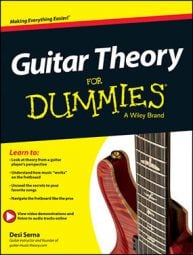On the guitar, if you take each triad from the major scale and play its notes as a common chord shape, you get seven chords. Here are the chords shown first in the open position and then as barre chords that move up the neck along the 6th and 5th strings.
![[Credit: Illustration courtesy of Desi Serna]](https://www.dummies.com/wp-content/uploads/419050.image0.jpg)
You can see how to do it at Chapter 3, Video Clip 4: Major Scale Chords in G.
Notice how the 1st, 4th, and 5th scale degrees produce major chords, while the 2nd, 3rd, and 6th scale degrees produce minor chords. These six chords are the ones most commonly used in music, you should memorize their qualities. From 1 to 6, the sequence is major-minor-minor-major-major-minor.
This sequence is one of the most important patterns in music. After all, you don’t just see it in the G major scale. Because you construct every major scale by using the same intervals, all the scales produce the same types of triads and the same major/minor chord sequence. So the 1st degree of every major scale makes a major chord, the 2nd makes a minor, and so on.

